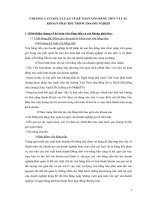Kinh nghiệm triển khai phẫu thuật tim ít xâm lấn tại BV ĐHYD, TP hồ chí minh
Bạn đang xem bản rút gọn của tài liệu. Xem và tải ngay bản đầy đủ của tài liệu tại đây (2.81 MB, 38 trang )
HOW SHOULD I SET UP
A MINIMALLY INVASIVE PROGRAM
UMC EXPERIENCES
DR. NGUYEN HOANG DINH
DR. LE MINH KHOI
HEART CENTER
UNIVERSITY MEDICAL CENTER
HO CHI MINH CITY
Why Minimally Invasive?
Patients benefits
Speed of recovery: “back to normal activities in 3 weeks”,
“decorated the house after 2 weeks”
The desire to avoid a sternotomy and have less pain
Minimally
invasive
Hospital/surgeon benefits
Large increase in referrals
Speed of recovery
Sternotomy
Invasiveness
But…
It is technically challenging for the first 75-125 cases
especially in inappropriately selected patients
Holzhey et al Cirulation. 2013:128(5):483-91
Almost poor outcomes can be attributed to
Learning curve of the operation
Patient selection
Sternotomy vs. MICS
Sternotomy: 3 month recovery, pain, 1-2% DSWI,
sternal precaution/no driving for 6 weeks
Minimally invasive: 3 times faster recovery, less pain,
shorter hospital stay, driving after 2 weeks, normal
activities in 3 weeks
But new complications can occur
Longer cross-clamp and CPB time
Retrograde perfusion
Phrenic nerve palsy <1%, groin seroma <5%,
conversion to sternotomy <2%
Before you start…
Paperwork, Ethical Board, commissioner approval
Generating referrals
Instrumentation and funding
Training
Training
Subspecialist training is essential
Technically challenging with a long learning curve
Fellowship, mini fellowship
Experiences of MV repair are helpful
Patients selection
Avoid:
Obese
Short statue
Aortic incompetence > trivial
Complex valves to repair – start with annuloplasty, PLP,
replacement
Other straight forward cases: ASD, tricuspid
annuloplasty, myxoma
Good instruments set makes
things lot easier
Long shafted instruments
Chitwood aortic clamps
LA retractor
LA retractor holder
Camera holder
Be creative!
Get your team support
Surgeons
Anaesthetists – neck line
insertion, TOE skills
Perfusionists – vacuum assist,
peripheral cannulation, higher
arterial line pressures
Scrub nurses – familiar with
instruments
Train together
Single vs double lumen ET tube
Size is not important, at first
Make bigger incisions as safety
is paramount
8-10 cm not 4cm for chest
4cm not 2cm for groin
Gentle rib spreading
As experience grows, incision
size can be reduced and metal
rib retractor can be abandoned
Venous drainage
It can be done using only femoral cannulation but
probably 10% cases having inadequate venous
drainage
Internal jugular vein cannulation?
Aortic occlusion: Chitwood clamps
Easier
Position more stable
Fewer dissection
Lot cheaper
Tricks to position it correctly without injuring left
appendage
Cardioplegia
Custadiol or del Nido: one shot of cardioplegia
Excellent myocardial protection up to 120 mins
The loop technique (Mohr)
Technical considerations
Correct intercostal space, 3rd or 4th – if in doubt,
choose the superior space
When canulating, always see the guidewire
intraluminally
Pericardial incision 3cm anterior to phrenic nerve









